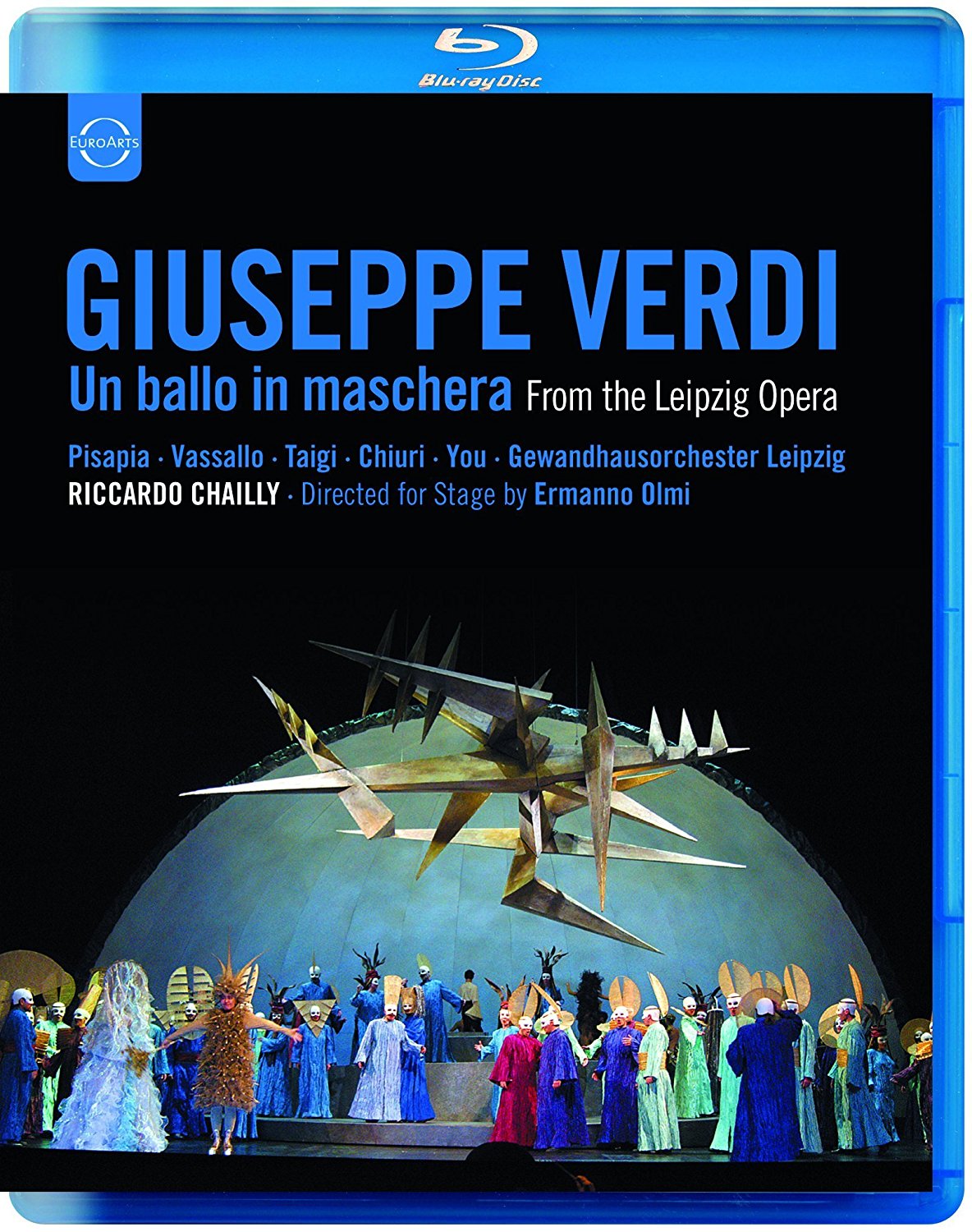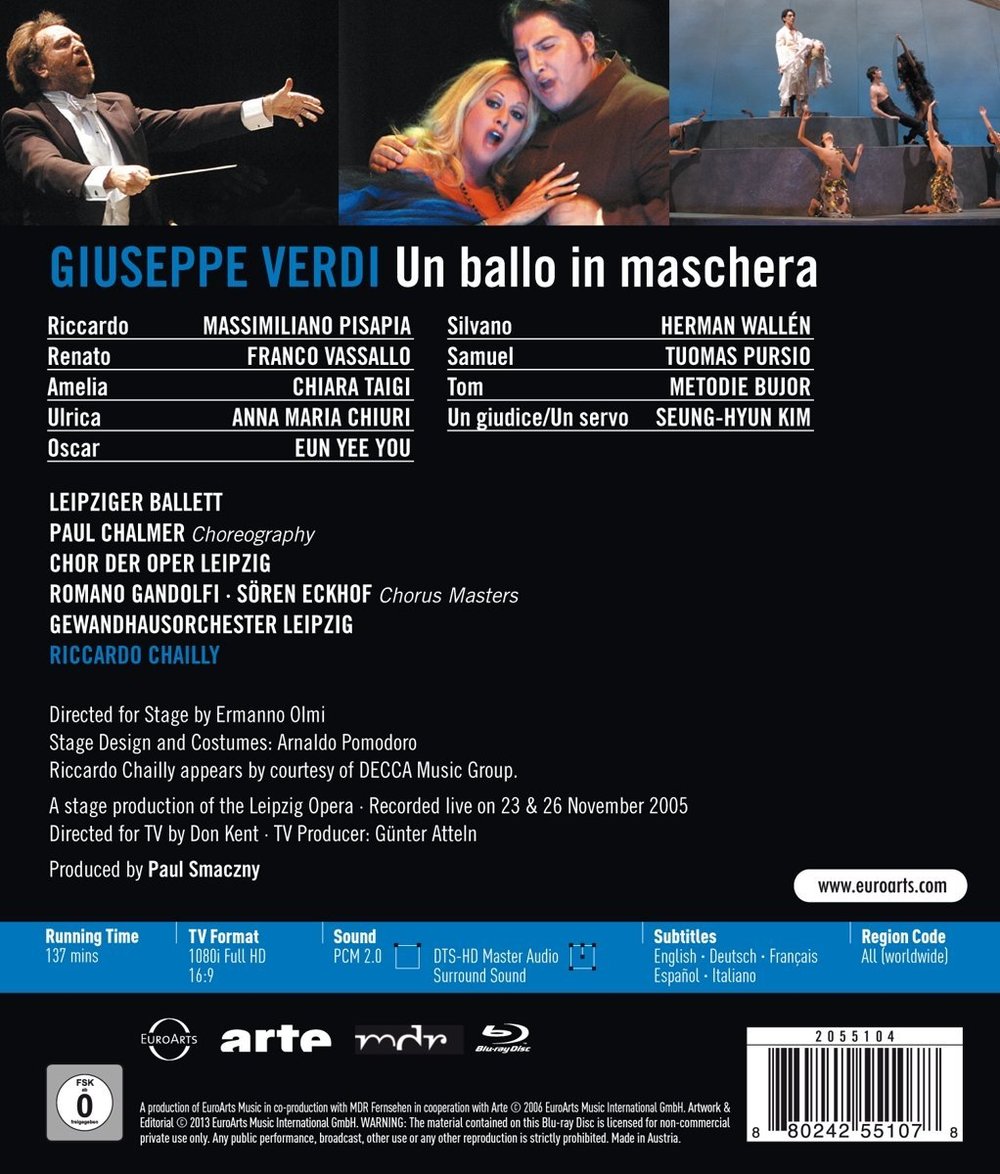

Verdi Un ballo in maschera opera to libretto by Antonio Somma. Directed 2005 by Ermanno Olmi at the Leipzig Oper. Stars Massimiliano Pisapia (Riccardo), Franco Vassalio (Renato), Chiara Taigi (Amelia), Annamaria Chiuri (Ulrica), Eun Yee You (Oscar), Herman Wallén (Silvano), Tuomas Pursio (Enemy of Riccardo), Metodie Bujor (Enemy of Riccardo), and Seung-Hyun Kim (Judge). Ricardo Chailly conducts (1) the Gewandhausorchester Leipzig, (2) the Chorus of the Leipzig Opera (Chorus Masters Romano Gandolfi and Sören Eckhof), (3) members of the Orchester der Musikalischen Komödie, and (4) the Leipzig Ballet. Sets and costumes by Arnaldo Pomodoro; choreography by Paul Chalmer. Directed for TV by Don Kent. Paul Smaczny was producer; produced for TV by Günter Atteln. Sung in Italian. Released 2013, disc has 5.1 dts-HD Master Audio sound. Grade: A
You can see from the artwork on the keepcase that this title has controversial designs. So let's hear now from several. First, here are comments from wonk John Aitken:
“Good things first. This is musically a first-rate Ballo. Massimiliano Pisapia is a suave, musically-intelligent Riccardo, Chiara Taigi a moving and finely sung Amelia, and Franco Vassallo a superb Renato, all marvellously supported musically by Maestro Chailly and the Gewandhaus orchestra. The Ulrica of Anna Maria Chiuri is not to my taste, producing some squally singing, but she is adequate. The Oscar of Eun Yee You is excellent, and the smaller roles are well taken. All in all, it's a musical joy. Bad things next. The costumes, an uneasy cross between early Doctor Who and Trumpton, the UK children's show, don't look particularly well made --- saggy knee pads are not a look to emulate. Ulrica suffers most as a kind of hedgehog --- very silly really. The costumes for the Ball itself are more thoughtful and look good in the final scene. The production and direction are basically bog standard--- nothing to complain about--- but really it is the musical values and the singing and acting of the main singers which give the most pleasure here. For that alone, even with the awful costumes, which at least are amusing, the performance deserves 5 stars.”
But Patrick Dillon, a print opera critic with vast experience, attacks both director Ermanno Olmi and designer Arnaldo Pomodoro with almost frightening intensity in the January 2014 Opera News at pages 63-64. In conclusion he asks, " . . . how could [conductor] Chailly have condoned the miserable spectacle that his two operatically illiterate compatriots [Olmi and Pomodoro] so maladroitly devised?" "Pomodoro" happens to mean "tomato" in Italian. Dillon jokes he was in the kitchen making dinner when he first saw some scenes from this Ballo. Dillon writes, ". . . if I'd had a few spare pomodori from my cooking, I'd have had a strong urge to hurl them at the screen."
Wow. We need some screenshots to see this for ourselves.
Let's start with an event shot. Here's the audience in Leipzig. Berlin, just a few miles north, is the world center for avant-garde Regieoper. But here in a cozy, modest house we have about as bald and gray of a gathering of opera fans as you could ever expect to see. How are they going to react to ripe tomatoes?
Now here's the opening scene showing the Court of Riccardo, Count of Warwick, Governor of Boston. (Nothing in this opera has the slightest connection to Colonial America. Verdi moved the scene to Boston in a desperate effort to satisfy the Italian censor.) Note the massive walls, which are good examples of the most prominent theme in the work of sculptor Pomodoro, i.e., an examination of the underlying structures, ligaments, and sinews that give strength to found objects. Now I'll stop to make a pitch: what's wrong with these walls in this scenario? Isn't the theme of this opera an examination of the underlying strength and weakness of two male protagonists?
The fanciful but drab costumes of the governor and his court co-exist in a real world of ordinary people. Here we see the page Oscar (Eun Yee You) talking to poor villagers. I should also mention now that Ermanno Olmi is an Italian neo-realist film maker whose work is generally oriented to social realism rather than romantic drama:
Now we have a close-up of Riccardo (Massimiliano Pisapia), who is thinking of Amelia, a woman he has fallen in love with:
Next we meet Renato (Franco Vassalio), the closest confidant and secretary to Riccardo. Here he dutifully warns Riccardo that enemies in the court are becoming dangerous. Renato is sincerely trying to protect his close friend and benefactor. Oh, by the way, the Amelia that Riccardo is mooning over happens to be Renato's wife:
There's a petition at court to get rid of a sorceress and seer named Ulrica (Anna Maria Chiara). Aitken says she looks like a hedgehog here. Dillon says she looks like "the Statute of Liberty wrapped in a desiccated Christmas tree." Well, what's wrong with this costume? Pomodoro likes spikes. The spikes here seem to be made of wood, which would be relatively easy for a rustic lady to work with. And didn't they used to burn witches in Europe? Well, this Ulrica is practically a walking bonfire!
Not a believer in black magic, Riccardo decides to visit Ulrica with members of the court. At the same time, Amelia (Chiara Taigi) consults Ulrica how to cure herself from loving a man other than her husband. Ulrica tells her to visit the gallows-field to pick herbs for a helpful potion:
Now Riccardo in disguise asks for his fortune to be told. Ulrica says he is of the nobility and will soon die at the hand of a friend:
When challenged to name the assassin, Ulrica say it will be . . .:
Suddenly Renato, still loyal, arrives and clasps the hand of Riccardo. Both men laugh at the fortune teller. But you know that Verdi never lets a curse or prophecy go unfulfilled:
Riccardo joins Amelia at the gallows-field, and she asks him to abandon their love:
But suddenly, Renato shows up! And through a misunderstanding of the sort only possible in opera, Renato is convinced that Amelia has been unfaithful. At first he says he will kill her, but then relents:
Renato joins the enemies of Riccardo in a plot to kill him at the upcoming masked ball. Here is the ball featuring, per Patrick Dillon, "an overhead plane collision" from Pomodoro:
Let's discuss Pomodoro a bit more. He is far better known around the world than anyone else connected with this Ballo production, including the conductor Riccardo Chailly. For example, 40 years ago the citizens of my home town of Charlotte, North Carolina, installed this Pomodoro "Big Disc" sculpture at the main downtown intersection:
There are scores, maybe hundreds, of major works of public art from Pomodoro all over the world. Arnaldo also designs objects like furniture and jewelry:
As well as giant works like this winery building in Italy:
So aren't we opera fans really lucky to get Pomodoro to join us in a Verdi production? In fact, Pomorodo has credits for at least 17 opera gigs. With these observations in mind, let's return to our Ballo. Here's a shot of some of the revelers:
And here are 3 of the assassins:
Renato isn't sure which reveler is Riccardo. He tries to bribe the page into telling:
Riccardo tells Amelia that, to end the temptation of their love, Renato and she will be posted immediately back to England:
The party is almost over---note the dancers are acting out the drama taking place behind the masks:
That's enough. There are still some twists to the plot that I'll not spoil for the newcomers.
With the screenshots above fresh in mind, I suggest you now read my review of a traditional Ballo HDVD performed in 2008 at the Teatro Real in Madrid. Then I hope my observations in the next paragraph will make sense.
Although Un ballo in maschera was inspired by a regicide in Sweden, it's not an historical opera. Different versions exist set in several counties. Setting it in America is unconvincing. Because it's about humane relationships and nothing else, you could stage it in a colony on Mars with an out-of-control computer as the fortune teller (would take some re-writing). So there's no reason other than habit for Ballo to be performed as a period costume piece. The dream world created by Olmi, Pomodoro, and staff works fine for me.
If you're free to stage this in a dream world bound to no past conventions, then why not create two versions, one optimized for the live audience and another optimized for the home theater? Movie-maker Olmi would be as well-qualified as anyone to take this dual approach. And videographer Don Kent, with at least 8 HDVDs to his credit, was fully qualified to capture the visions of Olmi and Pomodoro. From the "movie version", I offer 3 whole-or-near-whole-stage shots in this review and 16 near-range and close-up shots. In all his scenes, Olmi provides expert blocking and personal direction to his stars and directed them to tone down the histrionics in favor of a more natural delivery of their parts. Next (all critics agree) Chailly and the Leipzig band contributed outstanding playing and singing. Finally, PQ and SQ are excellent. The result in the HT is a show that draws the viewer into the action without really realizing that he is engaged with a dreamworld.
Alas, Pomodoros designs seemed to have initially frightened away much of the potential audience. But time is on Pomodero's side. After quite a few years on the market, the Amazon customer reviews for this title are overwhelming good. And considering all the opera HDVDs I've seen so far, I think subject title and the 2010 Benoît Jacquot Werther are the best examples we now have of an "opera movie" made from a live opera performance.
Now what kind of grade should we give this Ballo? Well, you can see that how impressed I am with the video. How about the live-music version? To comment on this, I'll go back to those bald and gray Bürger we started out with. As one can tell from the final few minutes of the video, they loved this live production and gave thunderous applause to everyone at the curtain calls including Pomodoro, who is easy to identify by his age and shiny pate. (There's no way to show something like this in screenshots, so you will have to take my word for it.) If this group of aging elders enjoyed this radical production, why shouldn't I?
So I'll overlook the objections of our critics and give this an "A." That's not the grade I thought I might be giving this when I first put the disc in the player.
OR

























